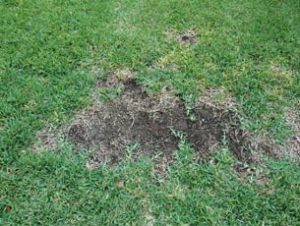Winter Lawn And Plant Care Tips in Austin, TX
 Brown Patch And Take-All Patch
Brown Patch And Take-All Patch
Although brown patch and take-all patch are similar at first glance, if you look closer you will see that they are different problems with different causes, modes of destruction, and cure.
Brown Patch
Brown Patch of turfgrass is caused by the fungus Rhizoctonia solani and may be referred to as Rhizoctonia blight. Brown Patch symptoms vary, depending primarily on turfgrass species and mowing height. Brown Patch occurs on dense, heavily watered turf in hot (above 85°F), humid weather when night temperatures remain above 60°F. Poorly drained soil, thick thatch, and night irrigation lengthen the period of leaf wetness and promote greater infection. High levels of nitrogen and low levels of phosphorous or potassium may contribute to increased disease severity. Mowing with a dull mower blade frays leaf blade tips and causes excessive wounding that enhances infection through those frayed blade tips. Brown patch damages the point where the blade of grass attaches to the stolen or “runner”. Since Brown Patch does not damage the stolen, the grass will re-grow in the spring and look healthy, and then repeat the cycle again in the fall. A preventative fungicide is the best answer to this problem, as Brown Patch is much easier to prevent than cure.
Take-All Patch
Take-all patch is caused by the fungus Gaeumannomyces graminis var. avenae. Take-all patch appears as ring-shaped dead areas that range from a few inches up to 3 feet or more in diameter. Roots are rotted and have dark strands of mycelium visible on the surface. Large, black, globular, fungal fruiting bodies (perithecia) may be visible with the use of a hand lens. Take-all patch generally occurs in the late fall and winter when temperatures are 50° to 60°F and soils are wet or moist. However, symptoms may not appear until the turf is exposed to periods of drought or heat stress. Soils light in texture, low in organic matter, or under fertilized with a high pH also contribute to disease development. Specifically, these soils are low in fertility and lack Zinc and Magnesium.
When differentiating between the two diseases, look at the stolen. With Brown Patch the stolen stay healthy and the grass will recover quickly. With take-all patch, the stolen dies, and recovery is slow and nutritional supplements are required, as well as the application of fungicides and pH monitoring and correction.
Caring For Your Houseplants
Heating systems cause low humidity which increase house plant’s need for water. You should mist plants a couple of times a day, and/or group them together, placing them on trays of pebbles with water. Be sure to check the moisture levels of the plants more frequently when the heater is running, watering only after the soil completely dries out, which reduces the chance of fatal soil fungi. Fertilize very little (if at all) during the winter months.
On cold nights (less than 32 F) protect all tender plants outside. It takes one good freeze to destroy many plants. Be cautious and prepare if you know that temperatures will fall into the low 40’s. Often times getting them close to the house will do, because of the radiant heat stored and released during the night. If you have a question or doubt about temperature, please give me a call or e-mail at Jerry@realgreenlawns.com. Place your plants where you want, but remember that they have needs. Ideally, they should receive light from a window. Avoid locations near a door or window that a cold draft could stress the plant. Check the soil daily, with your finger, watering only when the soil feels dry. If the pot is covered with decorative foil, be sure to punch some holes in the bottom, to allow the water to drain onto a saucer beneath the pot.
Pest Control
Bugs don’t take the winter off and can spread rapidly in a crowded indoor garden. Watch for pests and treat promptly. Be ready with a pre-mixed house-plant spray. Green Light makes a wonderful parathyroid based product, sold as bug-b-gone. Make sure you coat all the foliage completely, including the adjacent plants.
During the late winter and early spring the root systems of most warm season grasses decline, and as spring progresses, new vigorous roots develop. This time of year is a critical time in this process and these roots should not be disturbed. Aeration should wait until the grass is vigorously growing.
After a winter of not mowing, many of us are reluctant to get the mower out and start mowing. Watch the lawn, and if the growth is sufficient, mow.
Brown patch often forms in cooler wet temperatures. Although it is tempting to water to try and green it up, your lawn actually needs very little water this time of year. Brown Patch – Lawn Fungal Problems
Lawn Fertilizers applied this time of year should have low Nitrogen levels, to avoid feeding fungal problems such as brown patch and grey leaf spot.
Too much water can be devastating to most plants, including trees. There is no need to water established trees. If the weather is mild and dry, water newly planted trees thoroughly, as needed.
Consistent monitoring is the key to healthy plants. It is easier to keep a healthy plant healthy than to try to save a sick one.
